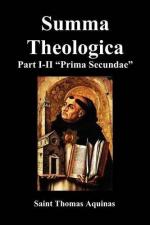Reply Obj. 1: Affirmation and negation are reduced to one same genus: e.g. in Divine things, begotten and unbegotten are reduced to the genus “relation,” as Augustine states (De Trin. v, 6, 7): and so “word” and “deed” denote equally what is said and what is not said, what is done and what is not done.
Reply Obj. 2: The first cause of sin is in the will, which commands all voluntary acts, in which alone is sin to be found: and hence it is that Augustine sometimes defines sin in reference to the will alone. But since external acts also pertain to the substance of sin, through being evil of themselves, as stated, it was necessary in defining sin to include something referring to external action.
Reply Obj. 3: The eternal law first and foremost directs man to his end, and in consequence, makes man to be well disposed in regard to things which are directed to the end: hence when he says, “contrary to the eternal law,” he includes aversion from the end and all other forms of inordinateness.
Reply Obj. 4: When it is said that not every sin is evil through being forbidden, this must be understood of prohibition by positive law. If, however, the prohibition be referred to the natural law, which is contained primarily in the eternal law, but secondarily in the natural code of the human reason, then every sin is evil through being prohibited: since it is contrary to natural law, precisely because it is inordinate.
Reply Obj. 5: The theologian considers sin chiefly as an offense against God; and the moral philosopher, as something contrary to reason. Hence Augustine defines sin with reference to its being “contrary to the eternal law,” more fittingly than with reference to its being contrary to reason; the more so, as the eternal law directs us in many things that surpass human reason, e.g. in matters of faith. ________________________
QUESTION 72
OF THE DISTINCTION OF SINS
(In Nine Articles)
We must now consider the distinction of sins or vices: under which head there are nine points of inquiry:
(1) Whether sins are distinguished specifically by their objects?
(2) Of the distinction between spiritual and carnal sins;
(3) Whether sins differ in reference to their causes?
(4) Whether they differ with respect to those who are sinned against?
(5) Whether sins differ in relation to the debt of punishment?
(6) Whether they differ in regard to omission and commission?
(7) Whether they differ according to their various stages?
(8) Whether they differ in respect of excess and deficiency?
(9) Whether they differ according to their various circumstances? ________________________
FIRST ARTICLE [I-II, Q. 72, Art. 1]
Whether Sins Differ in Species According to Their Objects?




